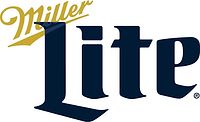![]()
With a Campaign Built on ‘choice,’ Miller Achieves the Unexpected
During this heated election year, the beverage industry saw a challenger of its own rise up, go
after the incumbent leader and pull off a surprising coup. This particular battle was among brewers rather than politicians,
but with an irreverent stab at overthrowing “the king of beers”
in favor of a “beer democracy,” Miller Brewing Co., Milwaukee,
reversed its sliding sales trend, and gave the industry a reason to
reconsider it as a serious contender.
When South African Breweries (SAB), based in London,
entered the U.S. market by purchasing Miller in 2002, it indicated the
company, which had steadily lost share during the previous few years, would
require at least three years to turn sales around. This year, about a year
and a half ahead of schedule, its flagship Miller Lite brand achieved
double-digit growth, picked up a full market share point, and climbed back
into the No. 2 spot in the light beer category, which had been taken over
by Coors Light.
SAB has said it had several goals for Miller, one of
which was to establish itself as a challenger. “We feel there’s
a natural space for a strong second player in a market as big as the
[United States], and that position should be occupied by ourselves,”
SABMiller Chief Executive Officer Graham Mackay told Miller’s
distributors during a meeting this year.
Other goals included creating a performance-driven
corporate culture, mending wholesaler relationships, and reconnecting with
consumers. Last year, SAB brought in new Chief Executive Officer Norman
Adami, known to be a tough-talking, performance-oriented leader, from its
South Africa business, and according to some, he has been instrumental in
defining the company’s new attitude.
“Under the focused leadership of Norman Adami,
the company has enjoyed real success in the United States over the last 18
months,” Bear, Stearns & Co. analyst Carlos Laboy wrote in a
recent report. “Miller Lite has surged, and the company has taken on
the cultural transformation of the previous sclerotic Miller Brewing into a
leaner, meaner, world-class competitor.”
Bump Williams, executive vice president and general
manager of global consulting at Information Resources Inc., and leader of
IRI’s beer, wine and spirits business, says of Adami, “Norman
is a very intelligent man, he is very charismatic, he’s great with
wholesalers and retailers, and he’s great for the industry itself. He
has reinvigorated and refocused the entire wholesaler team and leadership
team in Milwaukee.”
To the world at large, the most visible of
Miller’s initiatives has been reconnecting with consumers, and much
of the credit for the company’s sales increase has been given to a
new advertising campaign built around choice. The company fired its
infamous Cat Fight girls, dropping the sex-based ads so familiar to the
beer industry, and replaced them with humorous “attack” ads.
The company says the campaign was intended to remind
consumers they had a choice in beers. It created an election-themed ad that
told consumers “America is a democracy” and “beer needs a
democracy, too.” Later in the year, it took a lesson from the
1970’s Cola Wars, creating taste tests under the tagline
“Good Call” to compete with Anheuser-Busch’s
freshness advertising. By the end of next year, the company intends to hit
five million consumers with on-premise taste challenges.
Tom Pirko, president of Bevmark LLC, says an
aggressive position is a good one for Miller, and the irreverent humor has
helped breathe life into tired brands.
“People were looking at these brands and saying,
‘They don’t have the kind of validity they had in another era.
They’re looking old and like they really need to be restored.’
And what happened is that they were restored.
“The advertising has been central to what they’ve done,” he says. “A strategic
realignment comes in large part because of the way consumers perceive the
brands, and they’re now seeing these brands with a different
personality. [Miller is] the Pepsi to Coke, the challenger, the irreverent,
take-’em-on kind of thing. It’s the Daily Show. That’s a
good position for them, and they shouldn’t forget it.”
IRI’s Williams believes good timing, which
includes taking advantage of A-B’s Michelob Ultra and the focus it
put on low-carb beer, also played into Miller Lite’s success.
“The Miller Lite brand got a lot of support and additional business
from consumers’ focus on health, wellness and obesity, and the appeal
of light beer,” he says. “The new advertising that Miller came
out with really took advantage of that strong consumer need.”
Williams says the ad campaign is just part of the
company’s new attitude in favor of innovation. “Innovation
could be anything from new sales tools for the field sales force or
wholesalers, new types of analysis, new marketing tactics, new
packaging,” he says. “It’s not just new products;
it’s innovative ways of thinking, and that has been a really big
success story for Miller Brewing Co. this year.”
Among other examples of innovation are this
year’s packaging changes for Miller Lite, Miller Genuine Draft and
Genuine Draft Light. Primary and secondary packaging received a face lift,
including new embossed bottles, and the company became the first brewer to
use the popular Fridge Pack multipack. It touted the package with a
facetious commercial in which its “presidential candidate”
reminisced about his humble beginnings in a house that had a refrigerator
too small for a traditional multipack.
Mending ties
Of course, advertising alone does not a turnaround
make. One of Miller’s biggest challenges has been to rebuild loyalty
among its distributor customers, and that’s an endeavor that takes
time.
“We know exactly what you mean to our success,”
Mackay told distributors at its spring meeting. “That’s why we have
worked so hard to earn your trust — and why we are so intent on building
this new relationship... The fact is that historically, Miller didn’t
put itself in a position where they really could claim your support —
and we think we’re doing that now.”
On the distributor front, Pirko says progress has been made, but there is still a ways to go.
On the distributor front, Pirko says progress has been made, but there is still a ways to go.
“They’ve had some success under SAB
because they’ve been able to keep the ranks,” he says.
“The distribution system, although not working at great efficiency
yet, has become more enthused and a little more loyal to the parent
company.”
According to Laboy, “Miller has already made
great strides in its relationship with the wholesaler network.” He
cites a jump from No. 6 to No. 2 in a Tamarron wholesaler study, and the
sentiments of the Miller Wholesaler Council, a group of 11 key
distributors, as indications of the warming relationship between the brewer
and its distributors.
“Wholesalers indicated that they had not felt
this good about Miller in a generation, and that the rebirth of Miller Lite
and the repackaging and rebranding efforts against Milwaukee’s Best
and High Life are creating real traction in the market,” Laboy says.
But Citigroup analyst Bonnie Herzog believes the road
to repairing those relationships may be a bit longer. She recently reported
results of a beer wholesaler survey, taken this summer, that indicate while
25 percent of Miller wholesalers believe Miller Lite’s success can be
duplicated with MGD and Miller High Life, 75 percent expressed doubts.
According to Herzog’s report, “Even though
Miller Lite has been a success, many wholesalers do not believe this
success can be repeated with SABMiller’s other brands.”
But Pirko says the Lite effect is starting to shine on
other brands as well. “They’ve gotten better about holding this
Miller family together. They’ve gotten better about giving integrity
to High Life and pulling back MGD, which was looking really beaten up, and
giving both of these brands more integrity as part of the product
portfolio,” he says.
What’s next?
In addition to Miller brands’ improved sales, the industry has been buzzing with talk of other
big changes for the company, namely a possible merger with another big
North American brewer, be it Coors, Molson — or now that it appears
the two will gain approval for their merger — the combination of the
two.
“Strategically, as you look at the consolidation
map around the world, and if you look at how business is done in North
America, SABMiller and Coors need to be combined,” says Pirko.
“Even though they’ve had recent success against A-B, long-term
success depends on a lot of other fundamental business factors, starting
with simple mass. They need more sales and they need to unite their
distribution systems.
“The only way they’re going to hold and
continue to grow against A-B is not with clever advertising strategies but
with these fundamentals, and that only happens if they unite with
Coors.”
In Pirko’s opinion, the deal would have been
sweeter if SABMiller had gone after Coors only, rather than the combined
company, but in a recent report, Citibank South Africa analyst Grant
Swanepoel pointed to potential benefits in a Miller merger with Molson.
“[A] strong position in the Canadian beer market
can leverage Miller brands,” he said of a Molson merger. “Coors
and A-B are players in the market while Miller is left out in the cold...
There is a market for Miller’s products, but not a delivery
mechanism, and a deal with Molson could facilitate this.”
It also could boost Miller’s presence in the
U.S. import market, he said. But a strong import portfolio also is possible
through SAB, which owns dozens of brands in many corners of the world. The
company has indicated the United States can expect to see more from these
brands in the future.
“Within the SABMiller family, we have brands
such as Pilsner Urquell and Peroni, which we firmly believe to have the
ability to compete on the international stage,” Mackay told
Miller’s distributors.
According to industry-watchers, Miller stands to gain
more ground in the year to come if it is able to keep its aggressive stance
and continue to build the trust of its distributor partners. IRI’s
Williams points to several goals for the company, including keeping
wholesalers focused on fundamentals, keeping advertising fresh, continuing
innovation, managing pricing, and keeping an eye on the spirits and wine
trends that are giving the entire brewing industry a run for its money.
“If Miller arms its wholesaler network with insights into total
beverage alcohol, and uses tools like store-level data, we’re going
to see that momentum continue to grow and snowball,” he says.
And Pirko says, “They need to learn the lessons
of why they turned around. They turned around because beer took on a
different meaning with consumers. They found a secret formula in terms of
the way they communicate, and they can’t forget that.
“They also need to take advantage of the new,
renewed confidence with their distributors and retailers, and that means
making certain they stay happy,” he says. “They can’t go
to war with them like they did in the past.
There are new relationships out there that are based on a lot of optimism
so they need to keep those systems intact.”
BI




